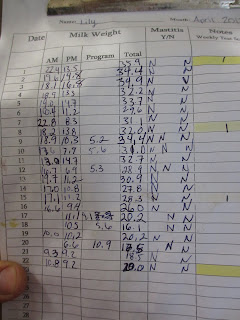Tuesday, April 24, 2012
Worth her weight in milk
posted by Andres
So, I’m sure it has been blogged about how Lilly, the 4 year old Holstein is back for another season as the Wagner Farm milking cow. We were all very excited for her return because she is a beautiful cow and most of the time really well tempered. If you have been by the farm since her return and watched a milking (4:30 every afternoon except Sundays) you may have noticed that the question and answer sessions while the milking machine is attached have gotten a lot shorter. The reason for that is Lilly’s milk output. She is currently giving anywhere between 15 and 35 lbs of milk per day, and that’s between 2 milkings, and believe me, the surge machine does not take long to get the apx. 10 lbs per milking and therefore does not allow me much time to answer all your questions. So now the real question, why is her output so low? There is no simple answer to that question but a multitude of factors. I am going to try and explain the main factors that play into her low output.
The first factor is a change in diet. Up at Golden Oaks, where Lilly spent the winter, she was eating a high output TMR diet (Total Mixed Ration or better known as Silage) which is formulated to help in milk production. This high output diet means that the cattle up there can be milked 3 times a day. Here at Wagner, Lilly is on a mainly grass diet with a ration of feed to help in her milk production. With this diet we cannot expect her to be outputting like she was up at Golden Oaks but, it is enough to keep her producing.
The second factor, which I believe to be the main cause, is the fact that Lilly has been milking since the birth of Daisy (the all white calf at Wagner) 14 months ago. For those of you who aren’t familiar with milking schedules, that is about 4 months longer than ideal. Once a cow gives birth and starts producing milk, she is ideally milked for about 305 days (or 10 months). The timeline starts when she freshens (gives birth), then, she is milked for about 4 months at which point that cow is bred again. Hopefully the breed takes and she is then milked for another 6 months. After that time period the cow is dried off so that she can put her energy into the calf during the last trimester of her pregnancy. Once she gives birth again, the cycle repeats. On smaller dairy farms the farmers usually try and time it so that the cow is dry during the winter and they therefore do not have to milk when it is cold outside. Not true for larger dairies which can have a birth a couple times a day. Unfortunately, Lilly did not take in the last few attempts to breed, so the answer is to keep her producing and continue to try and breed her. The reason for that is that if she is dried off before she is bred, she will just eat and get fat, and a fat cow has a harder time taking to breed.
Another factor that affects production is temperature. Although not a factor right now, you can see a decrease in production if temperatures get really cold or really hot. Apparently, Wisconsin had a substantial increase in milk production this past winter compared to the last few years due to the mild winter temperatures that the Midwest got this last season.
So, I am going to go ahead and apologize if you come by the farm for a milking and I don’t get around to answering your questions. Besides, the kids’ questions always get answered first, so if you are dying to know something have them ask…


